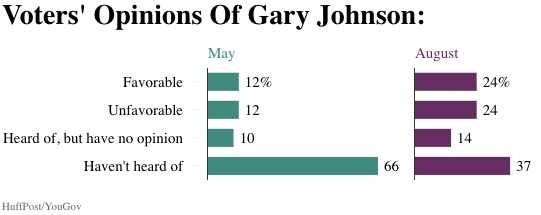
Speaking last week to CNN, Libertarian Party nominee Gary Johnson tried to spin his low name-recognition off as an advantage. “Seventy percent of Americans still don’t know who I am, and I think that bodes well for actually winning the race at some point,” he told the network.
For better or worse, Johnson was actually selling himself short. While he is still lagging in the horserace polls, trailing even the 15 percent he needs to secure a debate invitation, most voters now at least know who he is, a new HuffPost/YouGov survey finds.
Sixty-three percent of voters say they’ve heard of Johnson, up from just 34 percent three months earlier. Twenty-four percent of voters now view the candidate favorably; 24 percent view him unfavorably; 14 percent have heard of him but aren’t sure; and 37 percent still haven’t heard of him.

Green Party nominee Jill Stein, who wasn’t included in the May survey, is also now known to a majority of voters, although she’s somewhat less liked. Sixteen percent have a favorable opinion of her; 30 percent have an unfavorable opinion; 14 percent have heard of her but have no opinion; and 41 percent haven’t heard of her at all.

That’s far more notoriety than third-party candidates have attracted in the past. During Johnson’s 2012 run for president, for instance, a September Pew Research survey found that more than three-quarters of voters had never heard of him.
Still, Johnson and Stein remain lesser-known than nearly all of the Republican presidential hopefuls were in the beginning of January. And they’re still nowhere near matching the near-universal name recognition enjoyed by Hillary Clinton and Donald Trump.
Johnson’s increased name recognition also doesn’t seem to have done him much good in polls. HuffPost Pollster’s average shows Johnson pulling in less than 9 percent of the vote, a number that has remained largely unchanged during the past few months. Stein, when she’s included by pollsters, tends to take under 5 percent of the vote.
Even that may overstate the percentage of each candidate’s backers who actually make it to the polls.
Surveying races that include third-party candidates is a tricky prospect with no easy answers: Polls that ask about those candidates by name tend to overstate their support, while those that exclude them understate it.
And as SurveyMonkey’s Mark Blumenthal noted recently, “[T]he voters who opt for Johnson and Stein – often younger and more politically independent – are also less politically engaged and less likely to vote.”
According to SurveyMonkey’s tracking poll, nearly half of Johnson and Stein’s supporters give themselves a 50-50 or lower chance of actually voting for those candidates, and only about two-thirds of each candidate’s backers are certain that they’ll vote at all.
Still, in a race where more than a third of voters dislike both major candidates, the public seems willing to at least pay more attention than normal to the alternatives.
The HuffPost/YouGov poll consisted of 1,000 completed interviews conducted Aug. 25-26 among U.S. adults, using a sample selected from YouGov’s opt-in online panel to match the demographics and other characteristics of the adult U.S. population.
The Huffington Post has teamed up with YouGov to conduct daily opinion polls.You can learn more about this project and take part in YouGov’s nationally representative opinion polling. Data from all HuffPost/YouGov polls can be found here. More details on the polls’ methodology are available here.
Most surveys report a margin of error that represents some, but not all, potential survey errors. YouGov’s reports include a model-based margin of error, which rests on a specific set of statistical assumptions about the selected sample, rather than the standard methodology for random probability sampling. If these assumptions are wrong, the model-based margin of error may also be inaccurate. Click here for a more detailed explanation of the model-based margin of error.
